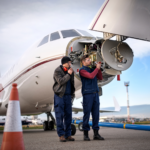The Most Important Issues Facing the Aviation Industry Today

Air travel and the aviation-centered economy have begun to soar back to pre-pandemic levels, with U.S. airlines reporting record bookings for summer travel in June 2022. Along with this, however, has come a steady increase in flight cancellations due to labor shortages.
To showcase and help us understand the many new developments in the aviation industry, the U.S. Chamber will host the Global Aerospace Summit on September 14 and 15, 2022, in Washington, D.C., where top leaders from commercial aviation, space, and defense will convene for conversations about the industry’s impact on the economy, trade, supply chains, cybersecurity, national security, workforce development, and more. Panelists and speakers will explore their visions for the industry of tomorrow. Register for the Global Aerospace Summit here.
As the Summit approaches, more businesses and investors should understand what is happening in the aviation sector. I spoke with aviation expert and Summit founder Carol B. Hallett, Of Counsel to the U.S. Chamber of Commerce, and asked the top questions leaders should know about the aviation industry in 2022.
With many people traveling this summer, they are noticing first-hand that airlines are facing major challenges, including numerous flight cancellations and delays. What are some of the underlying issues?
It is not a happy situation for the passengers or the airlines, but it is almost beyond our control. A lot of the issues boil down to there simply being a lack of workforce. That is from pilots to mechanics, to air traffic controllers, to ground crews, you name it. Unfortunately, that is not unique to the industry; almost every single business is faced with the same problem right now. The best thing we can do to correct this issue is to grow the talent pipelines that get these workers in the door. Airlines are working hard to recruit tomorrow’s workforce, and that cannot happen overnight. We will have two different panels on this topic at the summit this year, and I look forward to learning more about the strategies these airlines intend to employ.
Safety and security remain top issues for commercial aviation companies. What are they doing to continue improving in these areas?
If there is any one universal top priority of every airline worldwide, it is ensuring the safety and security of their passengers, crew, and the greater public. And even with workforce challenges and all the issues confronting the airline industry, they continue to maintain an unwavering commitment to safety and security. I feel highly confident that that will not change or lessen as the industry evolves.
What is the airline industry doing to promote and achieve more sustainability in air travel?
A more appropriate question might be, what isn’t the industry doing right now to achieve more sustainable air travel? I would say there are a few big things happening to achieve that.
First, we are redeveloping old technology — creating better engines, modeling more aerodynamic planes, and utilizing technology that makes sure planes get from point A to B as fast as possible with as minimal a carbon footprint as possible. Second, aviation fuel and engines are changing, with the industry looking at hydrogen, developing biofuels, and inventing new cleaner mixtures. The concept of electric airplanes is also very popular. Whoever thought ten years ago that we’d be talking about adding electric airplanes? Lastly, the industry is reinventing its day-to-day, seeing where it can cut flight time, shorten routes, and be more sustainable overall. It will be a long process, but the industry has made tremendous progress.
What role should the U.S. government and the Federal Aviation Administration play in improving today’s air travel?
Transportation has more regulations than many other industries. And that’s understandable because when you use equipment to move people, you need to ensure that everything is safe. However, the U.S. government and the Federal Aviation Administration (FAA) should be swift and efficient in their oversight as it relates to not only regulation of the industry but also how companies can implement improvements. Burdensome regulatory requirements can add ten-plus years to a project before approval, and that is never going to be acceptable in growth and innovation. While the FAA’s role in safety is essential, overregulation can be just as dangerous as under-regulation. At the end of the day, red tape can stifle innovation, so I think the government can work on getting things done a bit more efficiently.
The promise of commercial supersonic flight between continents appears to be on the verge of returning. And we might soon be able to take electrically powered air taxis around cities. How long will it take for supersonic flights and eVTOL to be accessible to the public?
These new technologies are exciting, but their timelines are still somewhat uncertain. Regulatory, safety, and noise concerns will certainly challenge these companies for years to come, but I also think COVID has impacted the timelines. Businesses, in some cases, lost two years of development, all faced staggering workforce issues, and we, unfortunately, saw several companies in the sector fold under the pressure. I am confident we will see this technology available to the public in the next decade as businesses recover from these challenges. We are all rooting for their success. The experts on the topic will be at the summit, so do not miss it.
Finally, as one of the executives leading the upcoming Global Aerospace Summit in mid-September, why should people plan to attend the event?
The nation’s eyes are on the aviation industry more so than ever before. When passengers think of aviation nowadays, they think of a post-COVID return to normalcy, they think of vacation, they may think of cancellations and delays, and they, of course, think of the excitement of flight. This is why it is so important to hear from the leaders of this industry and learn what they’re thinking. That’s what the Summit offers, a chance to listen, learn, and hear from these CEOs in a way we do not always get to. It will be fun, enlightening, informative, and an amazing networking opportunity.
This event has grown from just a couple of dozen people to now around 1,000 people participating. I am retiring later this year, so this will be my twentieth and final Summit since starting it way back in 2002. It is only fitting to make it bigger and better than ever before. We have come a long way. I don’t believe that any other organization has the reach or capability that the U.S. Chamber has to connect people worldwide.


